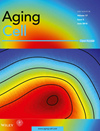
AGING CELL
老化細胞
- 影響因子:7.346
中文簡介
概述老化細胞的目標是發表高質量的,創新的研究解決衰老生物學的基本問題。為了在《衰老細胞》雜志上發表,這項工作必須為理解衰老做出重大的新貢獻,并引起社會的普遍興趣。《衰老細胞》試圖涵蓋老年科學的所有領域,強調揭示衰老過程的機械方面的研究,以及衰老與年齡相關疾病之間的聯系。將考慮對沒有實質力學見解的新老化過程的觀察,但對該領域應具有特別高的影響。主題包括但不限于,營養反應信號通路,神經和內分泌信號通路,組織相互作用,遺傳和表觀遺傳調控和完整性,蛋白質平衡,晝夜節律,活性氧和線粒體,細胞衰老,干細胞,progerias和干預,影響老化是鼓勵。所有的實驗方法,包括植物模型,都是受歡迎的。關注特定年齡相關病理的發病機制的論文也很有趣,但應該對衰老和疾病之間的基本聯系提供新的見解。目標和范圍衰老細胞覆蓋:遺傳學和功能基因組學:影響壽命的突變;基因的同源性;機體和細胞老化;基因操作。信號和基因表達:與年齡相關的變化與表型和生理聯系的機制;胞內信號;細胞與組織的相互作用;激素、免疫和炎癥系統。細胞增殖、衰老與死亡:復制性衰老;細胞凋亡;端粒生物學等內外因素的影響;時間細胞老化;老化細胞的表型。細胞應激和損傷:自由基對細胞和組織的外在和內在影響;自由基防御與損傷;自由基作為信號分子;壓力和衰老。干細胞與衰老:年齡對干細胞生成的影響遷移和體內平衡;莖cell-niche交互;監管機制。綜合生理學:機體、細胞和分子水平衰老過程的結果。生物人口學與比較研究:人口與跨物種比較研究。老年與長壽新理論:在已建立和新穎的老年與長壽理論的最廣泛層面上的討論。《衰老細胞》創刊于2002年,雙月刊。文章類型包括:新穎的,同行評審的研究,集中在上述領域。對近期備受矚目的研究進行評估。評注對期刊或其他主要期刊上當前特別重要的論文進行評價的評注。生物老化一般理論的發展與批判。關鍵字衰老,衰老,長壽,壽命,細胞衰老,細胞死亡,細胞凋亡,壓力,自由基,端粒酶,端粒,老年學,老年醫學抽象和索引信息學術檢索(EBSCO出版)學術搜索校友版(EBSCO出版)學術搜尋總理(EBSCO出版)CAS:化學文摘服務(ACS)CSA生物科學數據庫(ProQuest)Embase(愛思唯爾)InfoTrac(蓋爾Cengage)Ingenta選擇ISI提醒服務期刊引用報告/科學版(Clarivate Analytics)MEDLINE / PubMed(NLM)神經科學抽象(它)ProQuest生物科學收藏(ProQuest)PubMed膳食補充劑子集(NLM)科學引文索引擴展(Clarivate Analytics)
英文簡介
OverviewThe aim of Aging Cell is to publish the highest quality, innovative research addressing fundamental issues in the biology of aging. For publication in Aging Cell, the work must provide a major new contribution to the understanding of aging and be of general interest to the community. Aging Cell seeks to cover all areas of geroscience, highlighting research that uncovers mechanistic aspects of the aging process, as well as the links between aging and age-related disease. Observations of novel aging processes without substantial mechanistic insight will be considered, but should be of especially high impact for the field. Topics including, but not limited to, nutrient-responsive signaling pathways, neuronal and endocrine signaling pathways, tissue interactions, genetic and epigenetic regulation and integrity, proteostasis, circadian rhythms, ROS and mitochondria, cellular senescence, stem cells, progerias and interventions that affect aging are encouraged. All experimental approaches, including plant models, are welcome. Papers that focus on the pathogenesis of a specific age-related pathology are also of interest, but should offer new insights into the fundamental links between aging and disease.Aims and ScopeAging Cell covers:Genetics and functional genomics: mutations affecting longevity; gene homologies; organismal and cellular aging; gene manipulation.Signaling and gene expression: mechanisms linking age-associated changes with phenotypes and physiology; intracellular signaling; interactions between cells and tissues; hormonal, immune, and inflammatory systems.Cell proliferation, aging and death: replicative senescence; apoptosis; telomere biology and other intrinsic and extrinsic influences; chronological cellular aging; phenotypes of aging cells.Cell stress and damage: extrinsic and intrinsic influences of free radicals on cells and tissues; free radical defense and damage; free radicals as signaling molecules; stress and aging.Stem cells and aging: effects of age on stem cell generation; migration and homeostasis; stem cell-niche interactions; regulatory mechanisms.Integrative physiology: outcomes of aging processes at organismal, cellular and molecular levels.Biodemography and comparative studies: population and cross-species comparative studies.New theories of aging and longevity: discussion at the broadest level of established and novel theories of aging and longevity.Aging Cell was launched in 2002 and is published bimonthly. Article types include:Novel, peer-reviewed research, concentrating in the areas described above.Reviews and minireviews assessing high-profile recent research.Commentaries evaluating especially important current papers in the Journal or other leading journals.Development and criticism of general theories of biological aging.KeywordsAging, ageing, longevity, lifespan, cell senescence, cell death, apoptosis, stress, free radicals, telomerase, telomeres, gerontology, geriatric Abstracting and Indexing InformationAcademic Search (EBSCO Publishing)Academic Search Alumni Edition (EBSCO Publishing)Academic Search Premier (EBSCO Publishing)CAS: Chemical Abstracts Service (ACS)CSA Biological Sciences Database (ProQuest)Embase (Elsevier)InfoTrac (GALE Cengage)Ingenta SelectISI Alerting ServicesJournal Citation Reports/Science Edition (Clarivate Analytics)MEDLINE/PubMed (NLM)Neurosciences Abstracts (ProQuest)ProQuest Biological Science Collection (ProQuest)PubMed Dietary Supplement Subset (NLM)Science Citation Index Expanded (Clarivate Analytics)
近年期刊自引率趨勢圖
JCR分區
| JCR分區等級 | JCR所屬學科 | 分區 | 影響因子 |
| Q1 | CELL BIOLOGY | Q1 | 11.005 |
| GERIATRICS & GERONTOLOGY | Q1 |
近年期刊影響因子趨勢圖
CiteScore數值
| CiteScore | SJR | SNIP | 學科類別 | 分區 | 排名 | 百分位 |
| 13.80 | 2.751 | 1.770 | 大類:Biochemistry, Genetics and Molecular Biology 小類:Aging | Q1 | 2 / 36 |
95% |
| 大類:Biochemistry, Genetics and Molecular Biology 小類:Cell Biology | Q1 | 32 / 274 |
88% |
